
Wine Culture and Information since 2002 - Volume 22
 Wine Culture and Information since 2002 - Volume 22 |
|
Issue 75, June 2009 |
Contents |
|
|
Young Italians: Most Virtuous of Europe |
|
In a country like Italy - always rich in bizarre news and which not always put the emphasis on the good qualities of Italians, news which frequently tells about not truly praiseworthy and noble facts - when there are good news, besides pleasing quite a lot, it is right to let others know about them. At least for the satisfaction of knowing that also in Italy sometimes happens something good. During the few last months, the news are rightly focusing on the promotion of the so called “culture of wise drinking”, with particular preoccupation for young people, that generation of which will depend the future of our planet and of our society. The preoccupation - absolutely justifiable and founded - based on the not intelligent and not agreeable behavior in which young people adopt an excessive, inadequate and deplorable consumption of alcoholic beverages, with evident and predictable consequences in behavior and health. DiWineTaste has discussed many times about this preoccupying trend in young people - to tell the truth, it is something concerning adults too - because we are still convinced the wise consumption of alcoholic beverages it is not obtained with prohibitions, but with the spreading of a proper culture and information. To prohibit and to forbid do not mean to educate and to form, it simply means to repress, and repression inevitably causes feelings of revolt and revenge which will be manifested to the first possible occasion. We all have been young and we all know some behavior are adopted for the simple “pleasure” of breaking the rules and to show others how strong we are. We have always supported - and we still continue to do so - the correct and responsible consumption of alcoholic beverages is exclusively obtained with the spreading and the promotion of an intelligent culture, while trying to let people understand, because young people can be considered in many ways, but they certainly are not stupid. Young people pay attention to the ones who tell them things in the right way - with honesty and sincerity - giving them the possibility of forming a personal conscience. No one is stupid. A research promoted by Federvini (an Italian federation of wine producers) and done by ISPO (Istituto per gli Studi sulla Pubblica Opinione, Institute for Studies About Public Opinion) led by Mr. Renato Mannheimer, and having as a subject the consumption of alcoholic beverages among Italian young people, brings out interesting facts. Despite this news can be good when considered from a comparative point of view, it however brings out the fact there is still a lot to do in order to sensitize young people of the consumption of alcoholic beverages. The research done by ISPO brings out the consumption of alcoholic beverages among Italian young people is lower than the ones in other European countries. A news which is certainly good - if we consider it as something exclusively concerning Italy - and which emphasizes how among Italian young people it tends to prevail a form of culture of responsible drinking. The research focused on subjects having an age from 14 to 44 years, living in Italy, France, Germany and United Kingdom. One of the main results emerging from this research done by ISPO emphasizes that «the trend to an excessive consumption of alcohol in Italy is common in a small part of the country and greatly varies according to age». Specifically, in Italy the excess of consumption of alcoholic beverages is common for the 19% of subjects from 16 to 17 years, and reaches 23% from 18 to 19 years. The trend drops to 16% in subjects from 20 to 22 years, and drops to 12% in subjects from 23 to 29 years. In Germany and in the United Kingdom, the excessive consumption of alcoholic beverages is constant in all ages and it is higher than Italy. In United Kingdom the excess of alcohol is common for the 33% of young people of 14 years, 40% of those having 20 years, dropping to 25% in subjects of 40 years. In Germany reaches 50% in subjects of 14 years, 45% in subjects of 20 years and 22% in those of 40 years. Also the preoccupying and absolutely silly habit of binge drinking - that is the consumption of alcoholic beverages with the purpose of getting drunk - seems to be less frequent in Italy than in the rest of Europe. In Italy only 10% of young people admit to drink in excessive quantities, whereas in the United Kingdom the figure drops to 23% and to 27% in Germany. As for the first experience of excessive consumption of alcohol in order to get drunk, in Italy this happens from 17 to 18 years, whereas in Germany and in United Kingdom the age is from 15 to 16 years. 35% of the subjects surveyed in this study said they never got drunk, the figure drops to 23% in France, 14% in Germany, whereas in the United Kingdom this figure drops to 8%. Among the many results of this study, one in particular is pretty interesting. In Italy seems to prevail a responsible consumption instead of an excessive consumption or abuse of alcoholic beverages. In Italy it is in fact common the habit of spreading the consumption of alcohol in the course of the week: 25% in Italy, 17% in the United Kingdom and 10% in Germany and France. This habit can be explained also in cultural terms, as in Italy it is common to have one or two glasses of wines with meals, whereas in other countries they prefer concentrating the consumption of alcoholic beverages in a single day, in particular in Germany, a habit preferred by the 64% of people. The research also brings out Italians pay attention to quality: 70% believe in the rule of “drink less but of good quality”, a figure reaching 83% in subjects from 25 to 34 years. One of the accusations flung at young people is the connection between the consumption of alcohol and the sensation of “being adult”. 59% of Italians believe they do not consume alcohol for this reason, and also 40% of French people agree on this, as well as 38% of German and 25% of the people living in the United Kingdom. Only the 8% of Italians admit to consume alcoholic beverages in order to “be more self-confident”, a figure raising to 17% in Germany and 25% in the United Kingdom. It would be good also European young people to follow the example of Italians, an example which is also the undeniable result of culture, the Italian culture of wine, being more and more associated to moderation and quality. Well done, guys!
|
||||
Comparing Alto Adige LagreinAlto Adige, great land of white wines, also offers an excellent production of red wines, in particular Lagrein, its magnificent red berried grape |
|
This month we suggest our readers a new comparative tasting dedicated to the red wines of Alto Adige. This northern Italian region is mainly known for its white wines - crisp, aromatic and elegant - however in vineyards are also found many interesting red berried varieties with which are produced excellent wines. In the scene of red berried grapes found in Alto Adige, where in vineyards are frequently found international varieties - in particular Pinot Noir, Cabernet Sauvignon and Merlot - a grape is particularly known for its quality and which can be considered as the real glory of the region: Lagrein. A grape capable of giving great wines, Lagrein is used in Alto Adige for the production of two different styles, both being very interesting. The first one - and probably the most famous of the two - is “Lagrein Dunkel”, that is “dark”, it is a red wine produced according to the typical technique for red wines, and “Lagrein Kretzer”, that is “rose”, produced with a short maceration of the skins in the must. Lagrein is known in Alto Adige since the 1300s and are known two distinct varieties - Lagrein with a short cluster and Lagrein with a long cluster - both used for the production of Dunkel and Kretzer styles. The name Lagrein probably comes from Lagara, a colony of Magna Graecia, in the territory where today is found Basilicata region, famous for the Lagaritanos wine. Genetic researches done on this grape suggest Lagrein has some connections with Teroldego, Refosco dal Peduncolo Rosso and Syrah grapes. Thanks to its characteristics, Lagrein can be vinified as rose, producing interesting wines with a pleasing crispness and a pleasing olfactory profile. Most of the Lagrein is however vinified as red - and in this case in the label can also be found the term “dunkel” - obtaining wines of remarkable structure and pleasing crispness. Thanks to its good content in coloring substances, Lagrein Dunkel is also characterized by intense and deep colors, sometimes impenetrable to light.
|
|
Lagrein is a grape which prefers areas characterized by remarkable changes in temperature between day and night, specifically, pretty hot days followed by pretty cool nights, as well as a soil made of limestone and clay. This condition is generally found in the valley of Bolzano (Bozen) and it is right in this area are being produced the best expressions of wines made from Lagrein. According to the production disciplinary for Denominazione d'Origine Controllata wines of Alto Adige, Lagrein can be used together with Cabernet Sauvignon and Cabernet Franc, therefore obtaining Cabernet-Lagrein, and Merlot, obtaining Merlot-Lagrein. The disciplinary also provides for the use of the grape alone, therefore obtaining Lagrein, Lagrein Dunkel or Lagrein Scuro - in case the grape is vinified as red - and Lagrein Kretzer or Lagrein Rosato (Rose), in case the grape is vinified as rose. It should be noticed Lagrein can also be used for the production of other DOC wines of Alto Adige, usually blended to typical varieties of the territory.
Our comparative tasting will exclusively focus on three wines produced with 100% Lagrein and vinified as red, therefore to Lagrein Dunkel style. The three wines are all being aged in barrique, although for different periods of time, a wine making characteristic typical in the production of Lagrein wines. The first wine of our comparative tasting is Cantina Terlano's Alto Adige Lagrein Porphyr, aged for 18 months in barrique. The second wine is Produttori Colterenzio's Alto Adige Lagrein Cornell, aged for 16 months in barrique. The third wine of our comparative tasting is Cantina Produttori Bolzano's Alto Adige Lagrein Riserva Taber, aged in barrique for 12 months. The wines will be chosen according to the latest vintages commercialized by the respective producers and will be server at the temperature of 18°C (65°F). The tasting, as usual, will be done by pouring the wines in three ISO tasting glasses.
|
||||||||
|
Thanks to its content in polyphenols and coloring substances, wines produced with Lagrein and vinified as red, do not pass unnoticed to the eyes of the taster. In Lagrein Dunkel can in fact be observed intense and deep ruby red hues, with a pretty low transparency which can also avoid the passage of light. Also nuances confirm this characteristic of Lagrein, and in certain exemplars with some years of aging can be noticed a purple color which melts with a ruby red. It should however be noticed in some Lagrein Dunkel, generally the ones sold soon after the aging period passed in the cellar of producers, can be observed an intense ruby red color which tends to melt with purple. With time, Lagrein Dunkel wines follow the typical evolution of red wines, changing from ruby red to garnet red - although keeping a ruby red nuance - up to get, at the top of aging, a brick red hue. Let's start the appearance analysis of our comparative tasting from Cantina Terlano's Alto Adige Lagrein Porphyr. By holding the glass tilted over a white surface - a white sheet of paper or a white table cloth will be enough - let's evaluate the color of the wine by observing the liquid mass at the base of the glass. The color of this wine will show an evident deep ruby red and a pretty low transparency, whereas nuances - observing the wine at the edge, towards the opening of the glass - will show a purple red hue. Also the color of the second wine, Produttori Colterenzio's Alto Adige Lagrein Cornell, shows an evident deep ruby red color and a pretty low transparency, whereas nuances, as opposed to the previous wine, will show hints of garnet red. The color of the third wine, Cantina Produttori Bolzano's Alto Adige Lagrein Riserva Taber, confirms the characteristics of this grape's colors, showing a deep ruby red and a low transparency, with nuances of the same color.
|
|
Lagrein is a grape capable of giving great wines, with charming and exuberant aromas, complex and rich: the taster who will put the nose in a glass of Lagrein will not be disappointed. Among the most typical aromas of Lagrein Dunkel can be perceived the ones of red and black berried fruits as well as aromas recalling flowers. Lagrein Dunkel is generally fermented and aged in cask - frequently, the barrique - therefore in this wine can also be appreciated the typical aromas given by wood to the wine. The opening of Lagrein is generally characterized by aromas of black cherry, blackberry and blueberry, very intense and clean. Among flower aromas typical in Lagrein are mentioned violet and cyclamen. The aging in wood gives Lagrein tertiary aromas which recall spices and can also be found balsamic sensations, such as menthol and eucalyptus. The first wine of which we will examine the olfactory profile is Cantina Terlano's Alto Adige Lagrein Porphyr. By holding the glass in vertical position and without swirling, we will proceed with a first smell in order to appreciate the so called opening aromas, that is the aromas which develop from the wine with modest quantities of oxygen. From the glass are perceived intense and clean aromas of plum, black cherry and blackberry, three typical aromas which are frequently found in the opening of wines produced with this prestigious grape from Alto Adige. We will now proceed with the swirling of the glass, therefore favoring the oxygenation and the development of other aromas, completing the olfactory profile of the first wine. The second smell will allow the perception of the aromas of blueberry and violet, to which are added pomegranate, vanilla, tobacco, licorice, cocoa and pleasing balsamic sensations of menthol. It should also be noticed the pleasing hints of rhubarb and black pepper. Let's now pass to the evaluation of the second wine: Produttori Colterenzio's Alto Adige Lagrein Cornell. The opening of this Lagrein, evaluated without swirling the glass, is characterized by plum, black cherry and blueberry, also in this case, intense and clean. After having swirled the glass, let's proceed with the second smell which will complete the aromatic profile of the wine with blackberry, dried violet, vanilla, cocoa, licorice, black currant and the pleasing balsamic touch of menthol followed by a pleasing hint of white pepper. The opening of the third wine of our comparative tasting - Cantina Produttori Bolzano's Alto Adige Lagrein Riserva Taber - is characterized by intense and clean aromas of black cherry, plum and blueberry, also in this case typical in Lagrein. After having swirled the glass, let's proceed with the second smell in order to complete the olfactory profile of the wine with blackberry, violet, raspberry, cyclamen and “complex” sensations of vanilla, tobacco, cocoa, licorice and a strong balsamic character of eucalyptus.
|
||||
|
Depending on how it is used by the producer, Lagrein grape makes wines with pretty different characteristics, from medium bodied red wines to wines of remarkable and robust structure. The discriminating factor - together with the wine making practices - is represented by the quality of grapes and the way with which were cultivated in vineyard. Making Lagrein wines with a robust structure, first of all, means adopting viticultural practices in order to limit the yield, as Lagrein is a variety which tends to overproduction. In the best examples, Lagrein is characterized by pretty full structures, with a good presence of tannins giving the mouth a strong sensation of astringency. The frequent choice of fermenting and aging Lagrein in cask - most of the times in barrique - gives the wine a pleasing roundness contributing to the balance of tannins, to which contributes alcohol as well, that in this wine can also be higher than 13%. Let's start the gustatory evaluation of our comparative tasting from Cantina Terlano's Alto Adige Lagrein Porphyr. The attack of this wine - evaluated by taking a little sip from the glass - will reveal the nature of quality Lagrein, by emphasizing the astringent strength of tannins which find an excellent balance in the roundness provided by wood and alcohol. It should also be noticed the pleasing acid character of the wine. Let's now proceed with the second wine - Produttori Colterenzio's Alto Adige Lagrein Cornell - in which can be perceived the attack of tannins balanced by the roundness given by the aging in wood and alcohol. Also in this case it should be noticed the pleasing crispness of the wine and its robust structure. The attack of the third wine - Cantina Produttori Bolzano's Alto Adige Lagrein Riserva Taber - confirms the quality of the grape with a well perceptible astringency, although smoothed by the aging in wood, well balanced by alcohol. Also in this wine can be noticed a pleasing crispness and an evident full body.
|
|
Quality wines produced with Lagrein do not disappoint in the final phases of the tasting as well: in the mouth can be noticed their good persistence and their good body. The finish of Cantina Terlano's Alto Adige Lagrein Porphyr is persistent with intense and clean flavors of black cherry, plum and blackberry, a pretty frequent finish in wines produced with this grape. Also the finish of the second wine - Produttori Colterenzio's Alto Adige Lagrein Cornell - is persistent, leaving in the mouth intense and clean flavors of black cherry, plum and blueberry. The finish of the third wine of our comparative tasting - Cantina Produttori Bolzano's Alto Adige Lagrein Riserva Taber - is characterized by a long persistence in which can be perceived intense and clean flavors of black cherry, blackberry and plum, also in this case a typical finish. It should also be noticed, in all the three wines, the pleasing sensation of roundness having the effect of balancing crispness as well as a sensation of full and robust body.
|
Wines of the Month |
|
|
|
Score legend Prices are to be considered as indicative. Prices may vary according to the country or the shop where wines are bought |
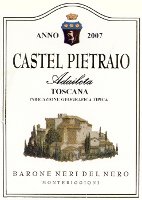
|
|
Adaileta 2007 |
|
| Fattoria di Castel Pietraio (Tuscany, Italy) | |
| Grapes: Chardonnay | |
| Price: € 12.00 | Score: |
| Adaileta shows a brilliant straw yellow color and nuances of straw yellow, very transparent. The nose denotes intense, clean, pleasing and refined aromas which start with hints of apple, plum and hazelnut followed by aromas of banana, vanilla, pear and hawthorn. The mouth has good correspondence to the nose, a crisp attack and however balanced by alcohol, good body, intense flavors, pleasing roundness. The finish is persistent with flavors of apple, plum and banana. Adaileta ages for 12 months in barrique followed by 3 months of aging in bottle. | |
| Food Match: Pasta with fish and mushrooms, Sauteed white meat, Broiled fish | |
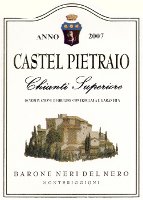
|
|
Chianti Superiore 2007 |
|
| Fattoria di Castel Pietraio (Tuscany, Italy) | |
| Grapes: Sangiovese (90%), Canaiolo Nero (5%), Merlot (5%) | |
| Price: € 7.00 | Score: |
| This Chianti Superiore shows a brilliant ruby red color and nuances of ruby red, moderate transparency. The nose denotes intense, clean, pleasing and refined aromas that start with hints of black cherry, plum and violet followed by aromas of blueberry, vanilla, carob and cinnamon. The mouth has good correspondence to the nose, a slightly tannic attack and however balanced by alcohol, good body, intense flavors, pleasing roundness. The finish is persistent with flavors of black cherry, blueberry and plum. This Chianti Superiore ages for 10 months in barrique followed by at least 3 months of aging in bottle. | |
| Food Match: Roasted meat, Broiled meat and barbecue, Stewed meat, Hard cheese | |
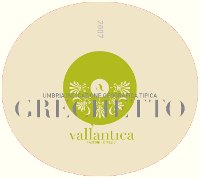
|
|
Grechetto 2007 |
|
| Vallantica (Umbria, Italy) | |
| Grapes: Grechetto | |
| Price: € 7.20 | Score: |
| This Grechetto shows an intense straw yellow color and nuances of straw yellow, very transparent. The nose denotes intense, clean, pleasing and refined aromas which start with hints of apple, plum and citrus fruits followed by aromas of hawthorn, pear, hazelnut and peach. The mouth has good correspondence to the nose, a crisp attack and however balanced by alcohol, good body, intense flavors, pleasing roundness. The finish is persistent with flavors of pear, apple and peach. This Grechetto ages in steel tanks. | |
| Food Match: Pasta and risotto with meat and mushrooms, Mushroom soups, Sauteed white meat | |
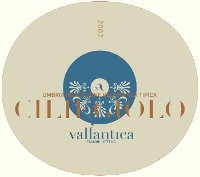
|
|
Ciliegiolo 2007 |
|
| Vallantica (Umbria, Italy) | |
| Grapes: Ciliegiolo | |
| Price: € 7.80 | Score: |
| This wine shows a brilliant ruby red color and nuances of ruby red, moderate transparency. The nose reveals intense, clean, pleasing and refined aromas that start with hints of cherry, plum and violet followed by aromas of strawberry, blueberry, cyclamen, raspberry, carob and menthol. The mouth has good correspondence to the nose, a slightly tannic attack and however balanced by alcohol, good body, intense flavors, pleasing roundness. The finish is persistent with flavors of cherry, blueberry and plum. This Ciliegiolo ages in steel tanks. | |
| Food Match: Stuffed pasta, Broiled meat and barbecue, Sauteed meat, Cheese | |
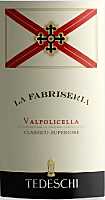
|
|
Valpolicella Classico Superiore La Fabriseria 2006 |
|
| Tedeschi (Veneto, Italy) | |
| Grapes: Corvina (35%), Corvinone (30%), Rondinella (30%), Oseleta (5%) | |
| Price: € 21.00 | Score: |
| Valpolicella Classico Superiore La Fabriseria shows an intense ruby red color and nuances of ruby red, little transparency. The nose denotes intense, clean, pleasing and refined aromas which start with hints of black cherry, plum and blackberry followed by aromas of violet, blueberry, vanilla, cocoa, tobacco, black pepper and menthol. The mouth has good correspondence to the nose, a tannic attack and however balanced by alcohol, good body, intense flavors, pleasing roundness. The finish is persistent with flavors of black cherry, plum and blackberry. Valpolicella Classico Superiore La Fabriseria ages for 18 months in cask followed by 6 months of aging in bottle. | |
| Food Match: Roasted meat, Stewed and braised meat, Hard cheese | |
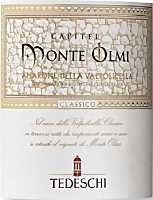
|
|
Amarone della Valpolicella Classico Capitel Monte Olmi 2005 |
|
| Tedeschi (Veneto, Italy) | |
| Grapes: Corvina (30%), Corvinone (30%), Rondinella (30%), Oseleta, Negrara, Dindarella, Croatina, Forselina (10%) | |
| Price: € 50.00 | Score: |
| Amarone della Valpolicella Classico Capitel Monte Olmi shows a brilliant ruby red color and nuances of ruby red, moderate transparency. The nose denotes intense, clean, pleasing, refined and elegant aromas which start with hints of blackberry, plum and violet followed by aromas of black cherry, blueberry, vanilla, chocolate, clover, green bean, mace, tobacco, pink pepper and menthol. The mouth has good correspondence to the nose, a tannic attack and however balanced by alcohol, full body, intense flavors, pleasing roundness. The finish is persistent with flavors of blackberry, plum and black cherry. A well made wine. Amarone della Valpolicella Classico Capitel Monte Olmi ages for about 3 years in cask followed by 6 months of aging in bottle. | |
| Food Match: Game, Stewed and braised meat, Roasted meat, Hard cheese | |

|
|
Trentino Cabernet Grener 2004 |
|
| Dorigati (Veneto, Italy) | |
| Grapes: Cabernet Sauvignon (50%), Cabernet Franc (30%), Carmenère (20%) | |
| Price: € 20.00 | Score: |
| Trentino Cabernet Grener shows a deep ruby red color and nuances of ruby red, little transparency. The nose reveals intense, clean, pleasing, refined and elegant aromas which start with hints of black currant, black cherry and plum followed by aromas of violet, vanilla, tobacco, blueberry, licorice, chocolate, black pepper and eucalyptus. The mouth has good correspondence to the nose, a tannic attack and however balanced by alcohol, full body, intense flavors, pleasing roundness. The finish is persistent with flavors of black currant, plum and black cherry. Trentino Cabernet Grener ages for 12 months in barrique followed by 4 months of aging in bottle. | |
| Food Match: Game, Roasted meat, Braised and stewed meat, Hard cheese | |
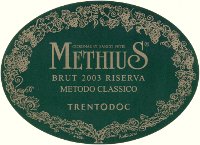
|
|
Trento Brut Riserva Methius 2003 |
|
| Dorigati (Veneto, Italy) | |
| Grapes: Chardonnay (60%), Pinot Noir (40%) | |
| Price: € 34.00 | Score: |
| Trento Brut Riserva Methius shows a brilliant straw yellow color and nuances of greenish yellow, very transparent, fine and persistent perlage. The nose reveals intense, clean, pleasing, refined and elegant aromas which start with hints of banana, bread crust and apple followed by aromas of pineapple, acacia, yeast, vanilla, grapefruit, plum, hazelnut, honey, kiwi, butter and hawthorn. The mouth has excellent correspondence to the nose, an effervescent and crisp attack, however balanced by alcohol, good body, intense flavors, pleasing roundness. The finish is very persistent with long flavors of banana, hazelnut, honey and grapefruit. A well made wine. Part of the Chardonnay ferments in barrique. Trento Brut Riserva Methius referments in bottle on its lees for 5 years. | |
| Food Match: Roasted fish, Broiled crustaceans, Pasta and risotto with fish, Roasted white meat | |
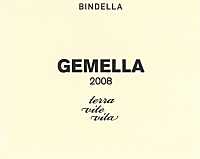
|
|
Gemella 2008 |
|
| Bindella (Tuscany, Italy) | |
| Grapes: Sauvignon Blanc | |
| Price: € 11.00 | Score: |
| Gemella shows a brilliant greenish yellow color and nuances of greenish yellow, very transparent. The nose reveals intense, clean, pleasing and refined aromas that start with hints of gooseberry, peach and nettle followed by aromas of elder flower, pear, apple, pineapple, broom and grapefruit. The mouth has good correspondence to the nose, a crisp attack and however balanced by alcohol, good body, intense flavors, agreeable. The finish is persistent with flavors of gooseberry, peach and pineapple. Gemella ages in steel tanks. | |
| Food Match: Pasta and risotto with fish and crustaceans, Sauteed crustaceans, Sauteed fish | |

|
|
Vin Santo di Montepulciano Dolce Sinfonia 2004 |
|
| Bindella (Tuscana, Italy) | |
| Grapes: Trebbiano Toscano (80%), Grechetto (20%) | |
| Price: € 27.00 - 375ml | Score: |
| Vin Santo di Montepulciano Dolce Sinfonia shows a deep amber yellow color and nuances of amber yellow, transparent. The nose reveals intense, clean, pleasing, refined and elegant aromas which start with hints of dried fig, walnut and honey followed by aromas of date, candied fruits, quince jam, dried apricot, almond, tobacco, vanilla, citrus fruit peel and nail polish. The mouth has good correspondence to the nose, a sweet and round attack, however balanced by alcohol, good body, intense flavors, pleasing crispness. The finish is persistent with flavors of dried fig, walnut and honey. A well made wine. Vin Santo di Montepulciano Dolce Sinfonia ages for 3 years in small barrels followed by 12 months of aging in bottle. | |
| Food Match: Confectionery, Dried fruit tarts, Piquant cheese | |
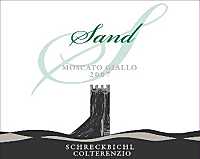
|
|
Alto Adige Moscato Giallo Sand 2007 |
|
| Produttori Colterenzio (Alto Adige, Italy) | |
| Grapes: Goldenmuskateller | |
| Price: € 12.00 | Score: |
| Alto Adige Moscato Giallo Sand shows a brilliant greenish yellow color and nuances of greenish yellow, very transparent. The nose denotes intense, clean, pleasing and refined aromas that start with hints of grape, pineapple and peach followed by aromas of lychee, apple, acacia, pear, sage, rosemary and lavender. The mouth has good correspondence to the nose, a crisp attack and however balanced by alcohol, good body, intense flavors, pleasing roundness. The finish is persistent with flavors of grape, pineapple and peach. Alto Adige Moscato Giallo Sand ages in steel tanks. | |
| Food Match: Vegetable soups, Broiled crustaceans, Sauteed crustaceans, Risotto with crustaceans | |
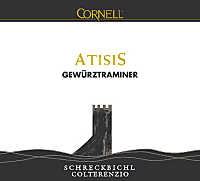
|
|
Alto Adige Gewürztraminer Atisis Cornell 2007 |
|
| Produttori Colterenzio (Alto Adige, Italy) | |
| Grapes: Gewürztraminer | |
| Price: € 22.00 | Score: |
| Alto Adige Gewürztraminer Atisis Cornell shows a pale straw yellow color and nuances of greenish yellow, very transparent. The nose reveals intense, clean, pleasing, refined and elegant aromas which start with hints of grape, peach and honey followed by aromas of white rose, lychee, acacia, pineapple, apple, pear, sage and lavender. The mouth has good correspondence to the nose, a crisp attack and however balanced by alcohol, good body, intense flavors, pleasing roundness. The finish is persistent with flavors of grape, peach and banana. Alto Adige Gewürztraminer Atisis Cornell ages for 6 months in steel tanks. | |
| Food Match: Broiled crustaceans, Broiled fish, Pasta and risotto with fish and crustaceans, Vegetable soups | |

|
|
Arbis Ròs 2005 |
|
| Borgo San Daniele (Friuli Venezia Giulia, Italy) | |
| Grapes: Pignolo (80%), Cabernet Sauvignon (15%), Cabernet Franc (5%) | |
| Price: € 24.00 | Score: |
| Arbis Ròs shows an intense ruby red color and nuances of ruby red, little transparency. The nose denotes intense, clean, pleasing and refined aromas that start with hints of black cherry, blackberry and plum followed by aromas of blueberry, violet, black currant, cocoa, vanilla, tobacco and eucalyptus. The mouth has good correspondence to the nose, a tannic attack and however balanced by alcohol, full body, intense flavors, pleasing roundness. The finish is persistent with flavors of black cherry, plum and blackberry. Arbis Ròs ages for one year in barrique followed by 6 months of aging in bottle. | |
| Food Match: Game, Roasted meat, Stewed and braised meat, Hard cheese | |

|
|
Arbis Blanc 2006 |
|
| Borgo San Daniele (Friuli Venezia Giulia, Italy) | |
| Grapes: Tocai Friulano, Chardonnay, Pinot Blanc, Sauvignon Blanc | |
| Price: € 21.00 | Score: |
| Arbis Blanc shows a pale straw yellow color and nuances of greenish yellow, very transparent. The nose reveals intense, clean, pleasing, refined and elegant aromas which start with hints of apple, peach and almond followed by aromas of honey, plum, banana, grapefruit, hawthorn, broom, pineapple, mineral and hints of vanilla. The mouth has good correspondence to the nose, a crisp attack and however balanced by alcohol, good body, intense flavors, pleasing roundness. The finish is persistent with flavors of apple, peach and banana. Arbis Blanc ages in cask. | |
| Food Match: Fish soups, Pasta and risotto with fish and crustaceans, Broiled fish | |

|
|
Aurente 2006 |
|
| Lungarotti (Umbria, Italy) | |
| Grapes: Chardonnay (90%), Grechetto (10%) | |
| Price: € 18.50 | Score: |
| Aurente shows a pale golden yellow color and nuances of straw yellow, very transparent. The nose reveals intense, clean, pleasing, refined and elegant aromas which start with hints of banana, toasted wood and hazelnut followed by aromas of acacia, apple, pear, vanilla, plum, praline, grapefruit, butter and mineral. The mouth has good correspondence to the nose, a crisp attack and however balanced by alcohol, good body, intense flavors, pleasing roundness. The finish is persistent with flavors of banana, plum, grapefruit and hazelnut. Aurente ferments and ages in barrique for 6 months followed by 8 months of aging in bottle. | |
| Food Match: Roasted fish, Roasted white meat, Pasta with meat, Stuffed pasta | |

|
|
San Giorgio 2003 |
|
| Lungarotti (Umbria, Italy) | |
| Grapes: Cabernet Sauvignon (50%), Sangiovese (40%), Canaiolo Nero (10%) | |
| Price: € 28.00 | Score: |
| San Giorgio shows a brilliant ruby red color and nuances of ruby red, moderate transparency. The nose reveals intense, clean, pleasing, refined and elegant aromas that start with hints of black cherry, plum and black currant followed by aromas of violet, vanilla, blueberry, cinnamon, cocoa, licorice, tobacco, pink pepper and eucalyptus. The mouth has good correspondence to the nose, a tannic attack and however balanced by alcohol, full body, intense flavors, pleasing roundness. The finish is persistent with flavors of plum, black cherry and black currant. San Giorgio ages for 12 months in barrique followed by 36 months of aging in bottle. | |
| Food Match: Roasted meat, Game, Braised and stewed meat, Hard cheese | |
News |
|
In this section are published news and information about events concerning the world of wine and food. Whoever is interested in publishing this kind of information can send us a mail to our address.
|
AquavitaeReview of Grappa, Distillates and Brandy |
|
|
| Distillates are rated according to DiWineTaste's evaluation method. Please see score legend in the "Wines of the Month" section. |
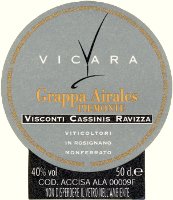
|
|
Grappa Airales |
|
| Vicara (Piedmont, Italy) | |
| (Distiller: Distilleria Rosignano Cellamonte) | |
| Raw matter: Pomace of Cortese, Chardonnay, Sauvignon Blanc | |
| Price: € 15.84 - 50cl | Score: |
| This grappa is colorless and crystalline. The nose denotes intense, clean and pleasing aromas of pear, hazelnut, apple, plum and peach with almost imperceptible alcohol pungency. In the mouth has intense flavors, with perceptible alcohol pungency which tends to dissolve rapidly, good correspondence to the nose, pleasing roundness and evident sweetness. The finish is persistent with flavors of apple, plum and hazelnut. Alcohol 40%. | |
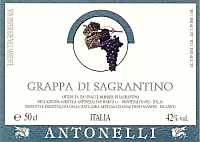
|
|
Grappa di Sagrantino |
|
| Antonelli (Umbria, Italy) | |
| (Distiller: Distilleria Nannoni) | |
| Raw matter: Pomace of Sagrantino | |
| Price: € 27.00 - 50cl | Score: |
| This grappa of Sagrantino is colorless, limpid and crystalline. The nose reveals intense, clean and pleasing aromas of blackberry, plum, violet, licorice, hazelnut, raspberry, blueberry and anise, with almost imperceptible alcohol pungency. In the mouth has intense flavors with perceptible alcohol pungency which tends to dissolve rapidly, good correspondence to the nose, pleasing roundness, balanced sweetness. The finish is persistent with flavors of blackberry, plum and hazelnut. This grappa is distilled with a bainmarie alembic still. Alcohol 42%. | |
Wine Parade |
|
|
| The best 15 wines according to DiWineTaste's readers. To express your best three wines send us an E-mail or fill in the form available at our WEB site. |
| Rank | Wine, Producer | |
|---|---|---|
| 1 |
| Aglianico del Vulture La Firma 2004, Cantine del Notaio (Italy) |
| 2 |
| Sangiovese di Romagna Superiore Riserva Thea 2005, Tre Monti (Italy) |
| 3 |
| Moscato d'Asti 2007, Vignaioli di S. Stefano (Italy) |
| 4 |
| Villa Gresti 2004, Tenuta San Leonardo (Italy) |
| 5 |
| San Leonardo 2001, Tenuta San Leonardo (Italy) |
| 6 |
| Sforzato di Valtellina San Domenico 2002, Triacca (Italy) |
| 7 |
| Arkezia Muffo di San Sisto 2004, Fazi Battaglia (Italy) |
| 8 |
| Sagrantino di Montefalco Collepiano 2003, Arnaldo Caprai (Italy) |
| 9 |
| Merlot 2004, Castello delle Regine (Italy) |
| 10 |
| Blanc des Rosis 2006, Schiopetto (Italy) |
| 11 |
| Barolo Bussia 2001, Prunotto (Italy) |
| 12 |
| Collio Bianco Col Disôre 2004, Russiz Superiore (Italy) |
| 13 |
| Chianti Classico Riserva Novecento 2000, Dievole (Italy) |
| 14 |
| Barolo Sorano 2004, Alario (Italy) |
| 15 |
| Sagrantino di Montefalco Passito 2004, Adanti (Italy) |
| |||||||
Privacy Policy | |||||||


| Copyright © 2002-2024 Antonello Biancalana, DiWineTaste - All rights reserved |
| All rights reserved under international copyright conventions. No part of this publication and of this WEB site may be
reproduced or utilized in any form or by any means, electronic or mechanical, without permission in writing from DiWineTaste. |